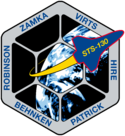Kathryn P. Hire
| Kathryn Patricia "Kay" Hire | |
 Kathryn P. Hire | |
| NASA-astronaut | |
|---|---|
| Född | 26 augusti 1959 Mobile, Alabama |
| Tid i rymden | 29 dagar, 15 timmar, 59 minuter, 1 sekund |
| Urvalsgrupp | Astronautgrupp 15 |
| Uppdrag | STS-90, STS-130 |
| Uppdragsemblem | |
Kathryn P. Hire, född 26 augusti 1959 i Mobile, Alabama, är en amerikansk astronaut uttagen i astronautgrupp 15 den 9 december 1994.
Rymdfärder
Media som används på denna webbplats
Astronaut Kathryn P. (Kay) Hire, mission specialist
STS-90 insignia
- The STS-90 crew patch reflects the dedication of the mission to neuroscience in celebration of the decade of the brain. Earth is revealed through a neuron-shaped window, which symbolizes new perspectives in the understanding of nervous system development, structure and function, both here on Earth and in the microgravity environment of space.
- The Space Shuttle Columbia is depicted with its open payload bay doors revealing the Spacelab within. An integral component of the mission, the laboratory/science module provided by the European Space Agency (ESA), signifies the strong international involvement in the mission. The seven crew members and two alternate payload specialists, Chiaki Naito-Mukai and Alexander W. Dunlap, are represented by the nine major stars of the constellation Cetus (the whale) in recognition of the International Year of the Ocean.
- The distant stars illustrate the far reaching implications of the mission science to the many sponsoring agencies, helping prepare for long-duration space flight aboard the International Space Station (ISS).
- The moon and Mars are depicted to reflect the crew's recognition that those two celestial bodies will be the next great challenges in human exploration of space and represent the key role that life science research will play in supporting such missions.
The official patch for STS-130. The shape of the patch represents the Cupola, which is the windowed robotics viewing station, from which astronauts will have the opportunity not only to monitor a variety of ISS operations, but also to study our home planet. The image of Earth depicted in the patch is the first photograph of the Earth taken from the moon by Lunar Orbiter I on August 23, 1966. As both a past and a future destination for explorers from the planet Earth, the moon is thus represented symbolically in the STS-130 patch. The Space Shuttle Endeavour is pictured approaching the ISS, symbolizing the Space Shuttle's role as the prime construction vehicle for the ISS.




